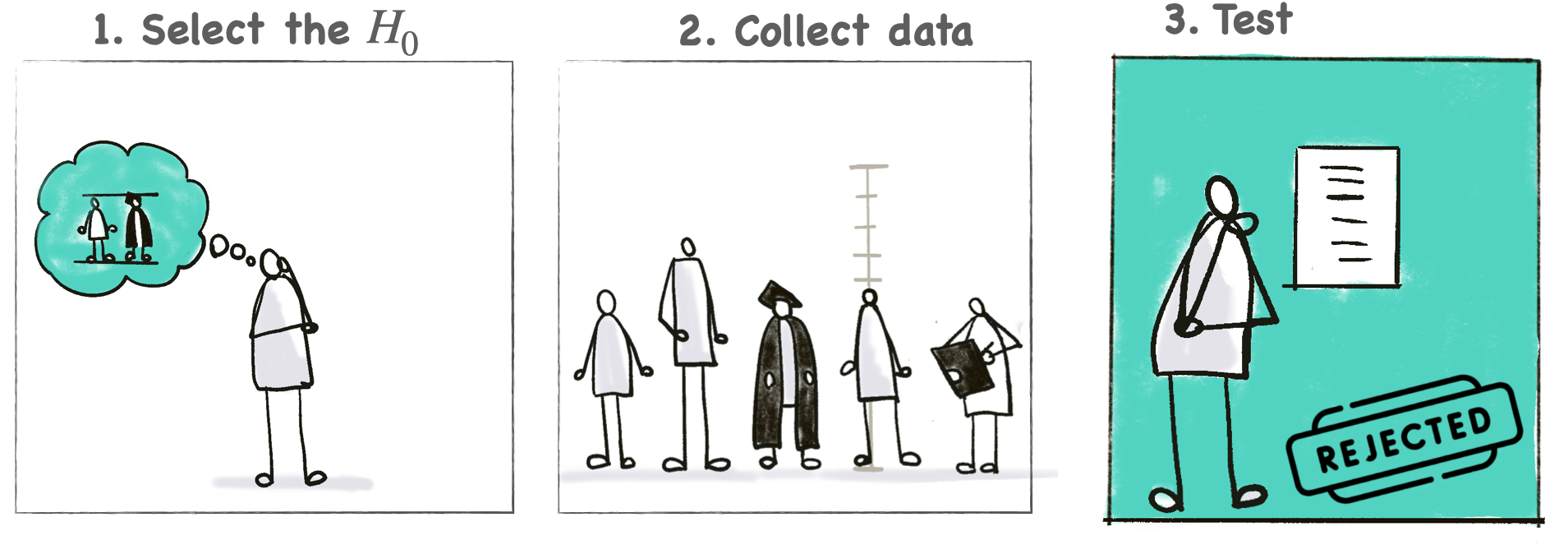Hypothesis testing for leakage assessment in side-channel analysis
This post has a slightly different format than previous posts, as the material was prepared for a three-hour in-person tutorial at the amazing summer school on real-world crypto and privacy in Vodice, Croatia.
The tutorial aims to give participants a solid technical understanding of the mechanics of hypothesis testing in the context of side-channel analysis. In the first part, we focus on the fundamental concepts of hypothesis testing: we practice choosing the null hypothesis $H_0$ (1), mention the data collection step (2) and take a deep dive into testing, which requires building the null-distribution estimating p-values (3).

Download the workbook and slides to follow alonghttps://github.com/ileanabuhan/talks_slides/blob/main/Croatia_23/NHST-part1.pdf) and work on the exercises in the suggested order. I use three running examples to illustrate these concepts. The first, Lake_water.ipynb is a one-sample t-test where we want to estimate the salt concentration in a body of water. The second, PhD_vs_Faculty.ipynb is a two-sample t-test where we test if height influences the chances of becoming a faculty member. Finally, the third example, Magic_coins, helps understand p-values.

In the workbook, you will find three exercises, pick and choose the one you find useful:
- The learning objective of exercise 1 is threefold: (1) we prove that there is natural variation when estimating a test statistic; (2) we determine the influence of the sample size samples on test statistics; and (3) we demonstrate that the distribution of the mean test statistic is different compared to the distribution of the sample data;
- The learning objective of exercise 2 is to practice constructing null distributions. In question 1, we explore what a t-score is and construct the null distribution for a one-sample t-test. In question 2, we construct a null distribution for a two-sample t-test, and in question 3, we construct a null distribution for data that follows a binomial distribution.
- The learning objective of exercise 3 is to get an intimate understanding of how p-valuesd what they represent. As a sanity check, compare the p-values we estimated with the ones calculated by the P are computed anython library.
In Part 2, we apply hypothesis testing, in particular, a two-sample t-test on a set of real traces collected for two algorithms. Use the same workbook and these slides for guidance.
Further reading:
-
The Reassure project produced an interesting tutorial on Understanding Leakage Detection worth checking out.
-
Carolyn Whitnall, Elisabeth Oswald: A Critical Analysis of ISO 17825 (‘Testing Methods for the Mitigation of Non-invasive Attack Classes Against Cryptographic Modules’). ASIACRYPT (3) 2019: 256-284;
-
François-Xavier Standaert: How (Not) to Use Welch’s T-Test in Side-Channel Security Evaluations. CARDIS 2018: 65-79
-
Tobias Schneider, Amir Moradi: Leakage Assessment Methodology - A Clear Roadmap for Side-Channel Evaluations. CHES 2015 495-513;
-
Lichao Wu, Léo Weissbart, Marina Krček, Huimin Li, Guilherme Perin, Lejla Batina, and Stjepan Picek, On the Attack Evaluation and the Generalization Ability in Profiling Side-channel Analysis, https://eprint.iacr.org/2020/899
-
Unai Rioja, Servio Paguada, Lejla Batina, Igor Armendariz: The Uncertainty of Side-channel Analysis: A Way to Leverage from Heuristics. ACM J. Emerg. Technol. Comput. Syst. 17(3): 40:1-40:27 (2021)